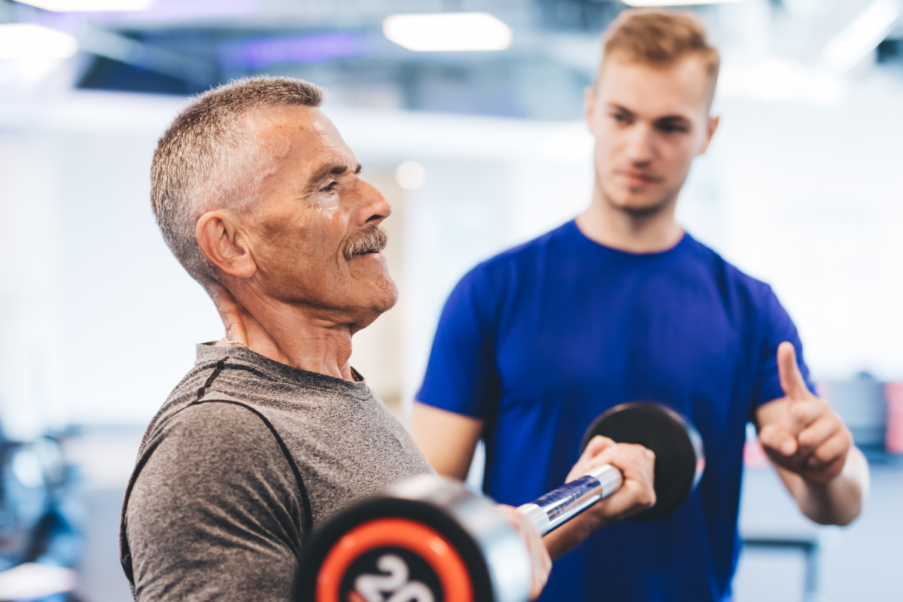How to Increase Confidence and Fitness Class Size
Revisit the basics and enhance the overall workout experience in your group fitness class.

Group fitness instructors have a reputation for being fearless extroverts. And it does take self-confidence to stand in front of a group of people and lead them through an exercise routine—all while wearing a mic and managing a playlist. The truth is that we’re performing, but that doesn’t come naturally to everyone. Some of us need to fake it till we make it!
Of course, nervousness tends to dissipate as we gain experience, but even veteran instructors need a little help from time to time. The payoff? When you upgrade your teaching skills with these confidence-boosting techniques, your classes will improve—and so will the experience for participants. Even if you’re as confident as they come, the following tips will help to keep your classes (and your schedule) full.
Face and Mirror the Class
Learning how to mirror is one of the biggest learning curves for many instructors. Demonstrating with your left arm while you cue students to use their right can be tricky, but it helps people pick up directions more quickly and keeps everyone moving in sync. Mastering this skill can give you more control over the room and increase your confidence level overall; it also helps students feel more confident because they hear and see clear instruction. What’s more, it lets you spot “outliers” right away. This is helpful, not so you can point out “right” or “wrong” moves, but so you’ll notice if a student needs assistance or may have a misalignment or an injury.
Mirroring also ensures that you’re facing the class, which allows you to make more eye contact. You’re in a better position to notice facial expressions and determine the group’s perceived exertion, enabling you to adjust your class plan as needed. “As an instructor, connecting with your participants makes the class experience that much more enjoyable for you, and direct eye contact is key for instructor and participant engagement,” says Staci Alden, group fitness director at PRO Sports Club in Bellevue, Washington. Simply put, Alden says when you face and mirror your class, “more people will take your class and be able to follow!”
See also: How to Keep Attendees in Class
Plan and Practice

One of the quickest ways to boost your confidence is to have a plan. “Everyone can tell when an instructor doesn’t have a plan,” says Alden. “Some pull it off better than others, but it is still obvious.”
A plan is a road map; it frees your mind to give other helpful information about a move or even lets you throw in a little personal flair. Alden says a well-planned class flows seamlessly and makes the workout more efficient and effective because it provides, for example, “equal use of opposing muscle groups, planes of motion and body parts, all of which help participants leave feeling balanced.”
Once you have a plan, you need to practice. If you practice in advance, you’ll be able to “focus less on making up what comes next and more on helping participants actually perform the exercises correctly,” says Alden, who adds that practice supports creative cuing on the fly. A bonus: You’re more likely to end class on time (you’ve likely noticed that unprepared instructors often end class early or go over on time).
Learn Musicality
Certain formats demand musicality (teaching to the music), but even if you don’t teach choreo┬¡graphy, understanding the beat is beneficial. “Music is such a powerful motivational tool, and our bodies naturally want to move to the rhythm!” says Lauren George, co-creator of the Enhanced Barre Above® Program and owner of Clemson Fitness Company in Clemson, South Carolina. “Teaching to the music allows instructors to bring a whole new level of fun, energy and creativity to their classes! It [can] help our students work harder for longer, provides a positive distraction from exercise-induced discomfort, allows students to ‘get in the zone,’ and activates certain emotion centers within the brain!”
From the instructor angle, “teaching to the beat allows you to focus on your students and cuing rather than [on] count┬¡ing repetitions, since the music will tell you when to switch to the next exercise,” says George, “It also allows instructors to express themselves creatively and add their personality.”
Be Flexible
While it’s crucial to plan and practice, you should also be flexible. “Fitness instructors always need to expect the unexpected,” says George. “People are looking to you to lead them through a workout. When the unexpected pops up, you need to be able to handle it with grace and a smile. Your students are there for a good workout, community and a fun experience. If you keep those three points in mind, other things become minor hiccups.” She suggests making an adventure out of a sudden location change, music problems, or an intensity change due to a spike in temperature.
Often, you’ll notice students follow your lead in more ways than one. If you act cool, calm and collected during surprise situations, you’ll likely experience few complaints.
See also: 6 Ways to Grow Your Fitness Classes
Use Concise Language

When you use clear, concise, direct cues, you appear confident and trustworthy. You’ll notice that your class runs more smoothly. Figure out what you want participants to do and then lead them through the move with as few words as possible. Avoid filler words such as “maybe,” “can you . . . ?,” “like,” “kinda” or “sort of” and just tell them what to do: “lift,” “breathe,” “rotate,” etc. Filler words give the impression that you aren’t sure what you’re doing, and students may question themselves (and you, too).
Keep learning
Although you are required to earn continuing education credits to maintain most certifications, think of it as an opportunity instead of an unwanted obligation. Attending continuing education courses allows you to learn something new, brush up on a familiar format or hone your safety skills, all of which give you more confidence to teach people how to move correctly while having a blast. Your students will benefit from your increased knowledge.
Editor’s note: Are you taking advantage of IDEA FitPro U Labs? Launched in March 2019, this is your source for free online courses. Each course is under 1 hour and includes activities to keep you on track and engaged. Plus, IDEA members can earn free CECs. Visit www.ideafit.com/fitproulabs today.
See also: Not So Fast: Questions to Ask Before You Accept That Fitness Class
Have Fun!
Most importantly, don’t forget to have fun! If you authentically enjoy yourself, you’ll feel more at ease, and that translates as confidence. Your students are looking for a break from their busy, stressful lives, so be a part of the solution by having an uplifting attitude. “People love group fitness because it’s fun!” says George. “If you aren’t having fun, your students certainly won’t.” And don’t take yourself too seriously. “We all mess up from time to time or say something silly,” she says. “It happens. Laugh and move on. Your students know you’re human, and it just makes you that much more relatable.”
If you’re a new instructor, understand that mistakes and missteps will lessen over time. “Think back to a time you learned something new, gave yourself time to practice and then compared your improvement to your past performance,” says Alden. “You knew you were improving and, therefore, gained confidence. By putting forth an honest effort to improve, it will not only inspire you to get better but also inspire others.”
Andrea Blair Cirignano
Andrea is a yoga and group fitness instructor and former group fitness supervisor in the Seattle area. She earned her bachelor's degree in journalism from the Edward R. Murrow College of Communication at Washington State University and writes health and fitness articles for a variety of publications.





